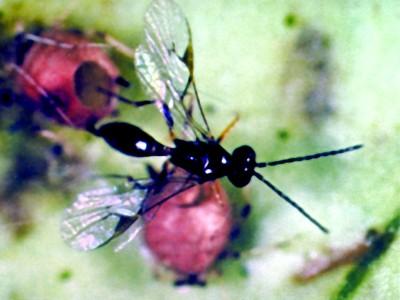The importance of parasitoid wasps
-
There are many species of parasitoid wasps, but most are so tiny that they are rarely noticed. What they lack in size they make up in sheer numbers and efficiency, and as a group they may be the single most important biological control method gardeners have.
-
Wasps belong to the order Hymenoptera, which includes more parasitoids than any other order of insects, with thousands of parasitic species in over 40 families.
-
Parasitoid wasps are very diverse in appearance, ranging in size from as small as a fleck of pepper up to nearly 3” long, and from uniformly dark in color to brightly colored and patterned. These tiny agents of death may be ectoparasitoids or endoparasitoids, but the good news is, they do not sting people.
Important species in Maryland
-
The most numerous and important species of parasitoid wasps in this area are in two superfamilies, Chalcidoidea (Chalcids) and Ichneumonoidea (Ichneumonoids). Among the more important Chalcid wasps are species in the Aphelinidae (Aphelinids), Chalcididae (Chalcidids), Encyrtidae (Encyrtids), and Trichogrammatidae (Trichogramma) families.
-
The more important Ichneumonoid wasps are species in one of two families, Braconidae (Braconids) and Ichneumonidae (Ichneumons) wasps.
Biology of parasitoid wasps
Appearance: Parasitoid wasps are typically so small – most range from the size of a fleck of pepper to under 1/2” long – that they can only be reliably identified by an expert.
Life stage(s) that feed on pests: Larvae. Adults usually feed on nectar, pollen, and honeydew, although a few may feed on host insects as well.
What do parasitoids feed on? In general, the eggs, larvae, and sometimes pupae of many insects, including aphids, caterpillars (larvae of butterflies and moths -Lepidoptera), sawflies, beetles, leafhoppers, true bugs, thrips, psyllids, and flies.
-
Two species of wasps are very important aphid parasitoids: Aphelinidae and Aphidius (Braconid wasps).
-
Trichogramma are endoparasitoids of the eggs of over 200 species of moths and butterflies, and are the most widely released biological control agents in North America.
-
Encrytids are highly successful generalist feeders that attack a wide range of host insects.
-
Ichneumons and Braconids are primarily parasitoids of dozens of different caterpillars (such as armyworms, cabbage looper, fall webworm, tent caterpillars, tomato fruitworm, redhumped caterpillar). Cotesia spp. (Braconid wasps) are important parasitoids of tomato hornworm and imported cabbageworm (see photo above)
Eggs: Are rarely seen, as they are usually inserted within the eggs or bodies of host insects.
Larvae: Are typically not seen, although some may be glimpsed as a dark shape within the body or egg of a host insect.
Pupae/Cocoons: The pupae of some parasitoid wasps may be seen as small whitish/yellowish, rice-like cocoons on or near parasitized insects.
Adults: Parasitoid wasps range in size from very tiny (some can fly through the eye of a needle) to about 1 ½ inch long. They are not interested in humans so therefore do not sting.
Where to find parasitoid wasps
Gardeners are more likely to see the results of parasitoids’ activities than the wasps themselves. Chalcid wasps can be found almost everywhere, particularly on flowers, foliage, and in leaf litter, but are rarely noticed because of their tiny size. They may be seen tapping leaf surfaces with their antennae in search of prey, and they leave sickly or dead hosts in their wake. Host eggs parasitized by Trichogramma may turn black as the wasp larva develops within.
How to attract and conserve parasitoid wasps
Parasitoid wasps are very sensitive to insecticides, so avoid or limit the use of chemical sprays. Most adults feed on plant fluids and sugars, so provide flowering plants that provide nectar sources. The best nectar sources are flowers with wide or shallow corollas where the wasps can easily reach nectar, such as members of the carrot (umbelliferae) and cabbage (cruciferae) families. Plants with floral nectaries are also important sources of food, as are aphids and other honeydew producing sucking insects. Plants that provide shade on hot summer days are a big help to parasitoids. Trichogramma wasps and those that attack scale insects, filth flies, aphids, and other insects can be purchased commercially for release, but it’s important to procure the right species to control the pest you have.




